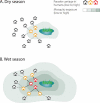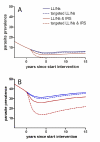Hitting hotspots: spatial targeting of malaria for control and elimination
- PMID: 22303287
- PMCID: PMC3269430
- DOI: 10.1371/journal.pmed.1001165
Hitting hotspots: spatial targeting of malaria for control and elimination
Abstract
Teun Bousema and colleagues argue that targeting malaria “hotspots” is a highly efficient way to reduce malaria transmission at all levels of transmission intensity.
Conflict of interest statement
AG was paid by GSK to attend a single advisory board meeting in December 2009 on how to develop models for the economic evaluation of RTSS. Currently she has a collaborative agreement with GSK to re-analyse RTSS Phase II trial data, which is managed via Imperial College but does not involve monetary exchange and under which the company does not have final decision on publication. None of these activities relates to this article on hotspots. All other authors have declared that no competing interests exist.
Figures


References
-
- World Health Organizatioin. Malaria elimination: a field manual for low and moderate endemic countries. Geneva: WHO; 2007.
-
- Snow RW, Rowan KM, Lindsay SW, Greenwood BM. A trial of bed nets (mosquito nets) as a malaria control strategy in a rural area of The Gambia, West Africa. Trans R Soc Trop Med Hyg. 1988;82:212–215. - PubMed
-
- Greenwood BM. The microepidemiology of malaria and its importance to malaria control. Trans R Soc Trop Med Hyg. 1989;83(Suppl):25–29. - PubMed
-
- Greenwood BM, Bradley AK, Greenwood AM, Byass P, Jammeh K, et al. Mortality and morbidity from malaria among children in a rural area of The Gambia, West Africa. Trans R Soc Trop Med Hyg. 1987;81:478–486. - PubMed
-
- Manning SD, Woolhouse ME, Ndamba J. Geographic compatibility of the freshwater snail Bulinus globosus and schistosomes from the Zimbabwe highveld. Int J Parasitol. 1995;25:37–42. - PubMed
Publication types
MeSH terms
Grants and funding
LinkOut - more resources
Full Text Sources
Medical

